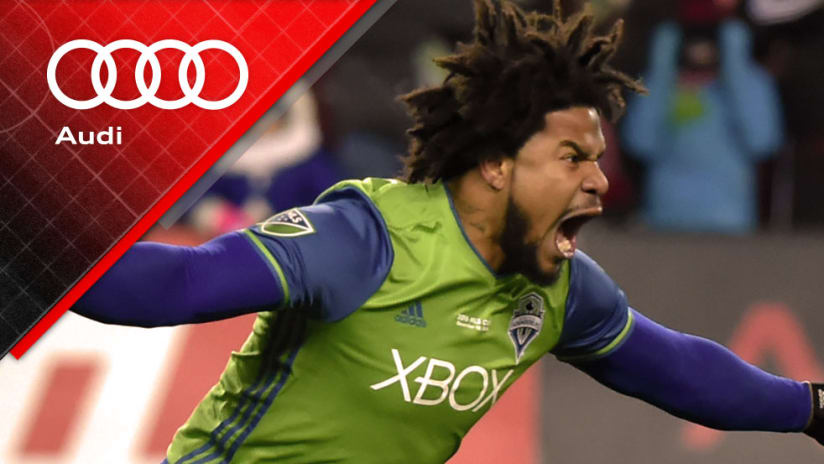Neither Seattle nor Toronto became Conference Champions by accident. Both clubs navigated demanding playoff series against worthy opponents and are now only a game away from hoisting the MLS Cup trophy.
As they prepare to face off, the sides will presumably set up in the same systems they have used throughout the playoffs: Toronto in their 3-5-2, Seattle in a 4-5-1.
In these formations, Seattle’s back four are more equipped to handle a variety of situations than their opponent’s three defenders (simply because they have an extra man). It is also safe to say Sebastian Giovinco and Jozy Altidore offer more combined quality up top than Seattle’s lone striker Nelson Valdez.
And so ultimately, though organized slightly differently, how do each side’s five-man midfields compare?
Midfield Contributions
Seattle have started matches with two defensive-minded and three attacking-oriented midfielders over the past two rounds of playoff action.
![Audi Playoff Analysis: Comparing Seattle Sounders, Toronto FC midfields - https://league-mp7static.mlsdigital.net/styles/image_default/s3/images/API_Blog_Graphic_12.8-01[1].jpg](https://images.mlssoccer.com/image/private/t_keep-aspect-ratio-e-mobile/f_auto/prd-league/udrsxzdo2eguuzhnvuc5.jpg)
(Andreas Ivanschitz stepped in for Erik Fribergin the second leg against Colorado)
On average, the starting midfield group tallied 48 percent of the team’s Audi Player Index total point output. The midfield’s contributions over each match are below.
![Audi Playoff Analysis: Comparing Seattle Sounders, Toronto FC midfields - https://league-mp7static.mlsdigital.net/styles/image_default/s3/images/API_Blog_Graphic_12.8-02[1].jpg](https://images.mlssoccer.com/image/private/t_keep-aspect-ratio-e-mobile/f_auto/prd-league/n64kfuo0bswx553hrnj8.jpg)
In Seattle’s most dominant playoff performance, their 3-0 victory over FC Dallas in Leg 1 of the Western Conference Semifinals, the starting five midfielders contributed to 52 percent of the team’s Audi Player Index point production. This was not only the performance most closely affiliated with their average of 48 percent, but also extremely close to exactly 50 percent.
In this way, it is clear that the Sounders are at their best when they are balanced in their performances — and, more specifically — when their midfield does half the work during the game and the combination of their back four and lone attacker do the other half.
The Reds line up a bit differently and often commit more of their midfielders forward than Seattle.
![Audi Playoff Analysis: Comparing Seattle Sounders, Toronto FC midfields - https://league-mp7static.mlsdigital.net/styles/image_default/s3/images/API_Blog_Graphic_12.8-03[1].jpg](https://images.mlssoccer.com/image/private/t_keep-aspect-ratio-e-mobile/f_auto/prd-league/uazsvcngabvzqvpdxno6.jpg)
(Will Johnson started in place of Osorio in the second leg against Montreal)
TFC’s midfield contributions breakdown is below.
![Audi Playoff Analysis: Comparing Seattle Sounders, Toronto FC midfields - https://league-mp7static.mlsdigital.net/styles/image_default/s3/images/API_Blog_Graphic_12.8-04[1].jpg](https://images.mlssoccer.com/image/private/t_keep-aspect-ratio-e-mobile/f_auto/prd-league/hvygspmqvm98ougeydey.jpg)
On average, Toronto’s starting midfield was responsible for only about a quarter of their team’s total Audi Player Index points. What’s more, their lone loss during the playoffs corresponded to the largest contribution from their midfield at 32 percent.
This confirms that Toronto are most successful when they play direct — pinging long balls vertically toward their attackers, often bypassing the midfield entirely as a result. And with their effort to then press and win the ball back higher, meaningful possession by midfielders is less important than occupying key space to force turnovers.
Bradley and Alonso
Each midfield unit’s ability to have just the right amount of impact on the game falls largely on two players: Michael Bradley and Osvaldo Alonso.
It will be up to Bradley to collect the ball from TFC’s three defenders and then play long, early, direct passes. If he is able to find a way to consistently do this without becoming too predictable, Seattle are in for a tough match.
If, on the other hand, Alonso is able to find pockets of space to connect the back line to the rest of the team, Toronto’s press will be ineffective. And by maintaining controlled possession from their defensive third into the middle third, Seattle may be able to find the necessary balance to see them through to victory.













